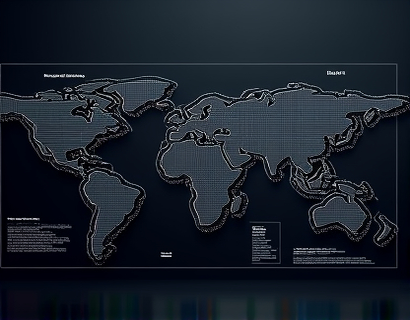Advanced Software for Graph Theory and Fluid Dynamics: Revolutionizing Research and Optimization
In the rapidly evolving fields of graph theory and fluid dynamics, researchers and engineers are constantly seeking tools that can enhance their analytical capabilities and streamline complex data analysis. Advanced software solutions have emerged to meet these needs, offering powerful features that drive innovative discoveries and performance optimization in intricate systems. This article delves into the capabilities and applications of these cutting-edge tools, designed specifically for experts in mathematical modeling and fluid mechanics.
Enhancing Graph Theory Research
Graph theory, a branch of mathematics that studies the properties and applications of graphs, has found extensive use in various domains such as computer science, network analysis, and optimization problems. Advanced software for graph theory provides researchers with robust methods to model, analyze, and visualize complex networks. These tools enable the manipulation of large datasets, facilitating the exploration of graph structures and the identification of critical nodes and paths.
One of the key features of these software solutions is their ability to handle large-scale graphs efficiently. Traditional methods often struggle with performance issues when dealing with extensive networks, but advanced algorithms and optimized data structures in modern software ensure rapid processing and accurate results. For instance, graph traversal algorithms such as Depth-First Search (DFS) and Breadth-First Search (BFS) are implemented with high efficiency, allowing researchers to explore and analyze vast networks with minimal computational overhead.
Visualization is another critical aspect of graph theory research. Advanced software offers sophisticated visualization tools that transform complex graph data into intuitive and informative visual representations. These visualizations help researchers identify patterns, trends, and anomalies that might be difficult to discern from raw data. Interactive visualizations enable users to manipulate the graph in real-time, exploring different scenarios and gaining deeper insights into the underlying structures.
Optimizing Fluid Dynamics Simulations
Fluid dynamics, the study of fluids in motion, plays a vital role in engineering, physics, and environmental science. Simulating fluid flow and heat transfer is essential for designing efficient systems in aerospace, automotive, and chemical engineering. Advanced software for fluid dynamics provides researchers with powerful computational tools to model and analyze these complex phenomena.
Computational Fluid Dynamics (CFD) is a key area where advanced software shines. CFD simulations involve solving the Navier-Stokes equations, which describe the motion of fluid substances. These equations are inherently complex and require significant computational resources to solve accurately. Modern software solutions leverage high-performance computing (HPC) techniques, parallel processing, and optimized numerical methods to handle these computations efficiently.
Mesh generation is a crucial step in CFD simulations. Advanced software offers automated mesh generation tools that create high-quality meshes tailored to the specific geometry of the problem. These tools support various mesh types, including structured, unstructured, and hybrid meshes, ensuring accurate and efficient simulations. Adaptive mesh refinement techniques further enhance the precision of the simulations by dynamically adjusting the mesh resolution based on the flow characteristics.
Visualization in fluid dynamics is equally important. Advanced software provides comprehensive visualization capabilities that allow researchers to observe and analyze fluid flow patterns, pressure distributions, and temperature gradients. Volume rendering, streamline visualization, and vector field plots are some of the advanced visualization techniques available, enabling a detailed understanding of the fluid behavior. These visualizations are not only useful for research but also for educational purposes, helping students and professionals grasp complex fluid dynamics concepts.
Integration and Multidisciplinary Applications
The true power of advanced software for graph theory and fluid dynamics lies in its ability to integrate multiple disciplines and applications. Researchers often face problems that span both graph theory and fluid dynamics, requiring a unified approach to analysis. Advanced software solutions facilitate this integration by providing a comprehensive platform that supports both domains.
For example, in the field of network flow, graph theory and fluid dynamics can be combined to model and optimize transportation systems. Advanced software allows researchers to model road networks as graphs and simulate fluid flow to represent traffic patterns. By optimizing the graph structure and analyzing the fluid dynamics, researchers can identify bottlenecks and propose efficient solutions to improve traffic flow.
Another multidisciplinary application is in environmental modeling, where graph theory can be used to model ecological networks and fluid dynamics to simulate water flow and pollution dispersion. Advanced software enables researchers to create integrated models that consider both the network structure and the fluid dynamics, providing a holistic view of environmental systems. This integrated approach is crucial for developing sustainable solutions and understanding the impact of human activities on natural ecosystems.
User-Friendly Interfaces and Advanced Analytics
To ensure that these advanced tools are accessible to a wide range of users, modern software solutions focus on user-friendly interfaces and comprehensive analytics. Intuitive graphical user interfaces (GUIs) guide users through the analysis process, from data input to result interpretation. Step-by-step wizards and interactive tutorials help users, especially those new to these fields, to leverage the full potential of the software.
Advanced analytics features are another hallmark of these software solutions. Statistical analysis, sensitivity analysis, and uncertainty quantification are built-in functionalities that provide deeper insights into the results. Researchers can perform regression analysis, hypothesis testing, and confidence interval calculations to validate their findings and ensure the reliability of their models.
Data export and sharing capabilities are also essential. Advanced software allows users to export results in various formats, such as CSV, PDF, and interactive web visualizations. This flexibility ensures that researchers can share their findings with colleagues and publish their results in academic journals, facilitating collaboration and knowledge dissemination.
Case Studies and Real-World Impact
The impact of advanced software in graph theory and fluid dynamics can be seen in numerous real-world applications. In the aerospace industry, CFD simulations powered by advanced software have led to the design of more efficient aircraft and spacecraft. By optimizing aerodynamic properties and reducing drag, these simulations contribute to fuel savings and improved performance.
In the field of urban planning, graph theory and fluid dynamics software has been used to model traffic and public transportation systems. Researchers have applied these tools to optimize traffic signal timings, reduce congestion, and improve public transit efficiency. The insights gained from these simulations help city planners make data-driven decisions that enhance the quality of life for residents.
A notable example in environmental science is the use of integrated graph and fluid dynamics models to study river systems and coastal erosion. By modeling the network of rivers and simulating water flow and sediment transport, researchers can predict erosion patterns and develop strategies to mitigate the impacts of natural disasters such as floods and tsunamis.
Future Trends and Developments
The field of advanced software for graph theory and fluid dynamics is continually evolving, driven by advancements in computing technology and the increasing complexity of research problems. One emerging trend is the integration of machine learning and artificial intelligence (AI) techniques into these software solutions. AI algorithms can enhance the automation of mesh generation, optimize parameter settings, and even predict flow behavior based on historical data.
Another area of development is the expansion of cloud-based platforms, which provide scalable computing resources and collaborative environments. Cloud-based software allows researchers to access high-performance computing infrastructure on-demand, reducing the need for expensive local hardware and enabling larger-scale simulations.
Furthermore, the growing importance of sustainability and climate change research is pushing the boundaries of what these software tools can achieve. Advanced models that incorporate environmental factors, such as temperature changes and sea-level rise, are becoming increasingly relevant. Researchers are developing software that can simulate the interactions between complex systems and environmental changes, providing valuable insights for policy-making and conservation efforts.
In conclusion, advanced software for graph theory and fluid dynamics is revolutionizing research and optimization in these fields. By providing powerful tools for data analysis, visualization, and simulation, these software solutions empower researchers and engineers to tackle complex problems and drive innovative discoveries. As technology continues to advance, the potential for further improvements and new applications remains vast, ensuring that these tools will remain at the forefront of scientific and engineering research.










































